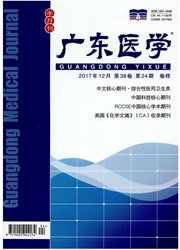

 中文摘要:
中文摘要:
目的 比较人与山羊上胸椎标本在体外的三维生物力学特征.方法 取新鲜成年人尸体与波尔山羊上胸椎标本(C7-T5)各8具,在脊柱三维运动测试系统上检测两者在屈曲、后伸、左右侧屈、左右轴向旋转模式下的三维运动范围(ROM).结果 在前屈运动方式下,人与山羊C7-T1的ROM分别为(7.1±1.0)°和(7.8±1.6)°,超过其他节段.在后伸运动方式下,人与山羊C7-T1的ROM分别为(5.6±1.1)°和(6.3±1.6)°,超过其他节段.在左右侧屈运动方式下,人与山羊T2-3的ROM分别为(7.2±0.9)°和(8.1±1.3)°,超过其他节段.在轴向旋转运动模式下,人与山羊自上而下ROM逐渐递增,T4-5最大,分别为(4.6±0.9)°和(5.0±0.8)°.除人C7-T1左右侧屈的ROM及中性区(NZ)小于山羊(P〈0.05)外,其他节段三维运动的ROM和NZ两者相比差异均无统计学意义(P〉0.05).结论 人与山羊在前屈、后伸、左右侧屈和轴向旋转等运动模式下的ROM及NZ基本一致,可作为人上胸椎研究的动物模型.
 英文摘要:
英文摘要:
Objective To compare the three - dimensional biomechanical characteristics of the upper thoracic vertebrae between human and goat. Methods Fresh upper thoracic spines from were harvested from 8 adult human cadavers and 8 Boer goats. The range of motion (ROM) and neutral zone (NZ) of the specimens were tested respectively in three - dimensional testing systems under flexion, extension, fight bending, left bending and axial rotation loads. Results Under flexion load, the ROM of C7 - T1 of humans and goats were (7. 1 ±1.0) ° and ( 7.8 ±1.6 ) °, respectively, larger than between the other levels. Under extension load, the ROM of C7 - T1 of humans and goats were (5.6 ±1.1 ) ° and (6. 3 ±1.6) ° , respectively, larger than between the other levels. Under fight or left bending torques, the ROM ofT2-3 of humans and goats were (7.2 ±0. 9) ° and ( 8.1 ±1.3 ) ° , respectively, larger than between the other levels. Under axial torques, the ROM of T4-5 of humans and goats were (4. 6 ±0.9) o and (5.0 ±0. 8) °. However, there was no significant difference in ROM or NZ among all segments between goat and human (P 〉 0. 05 ), except those of C7 - T1 under right or left bending torques. Conclusion Boer goat has similar biomechanical characteristics with human under flexion, extension, right or left bending and axial rotational loads, it can be served as an optimal model for upper thoracic research.
 同期刊论文项目
同期刊论文项目
 同项目期刊论文
同项目期刊论文
 期刊信息
期刊信息
